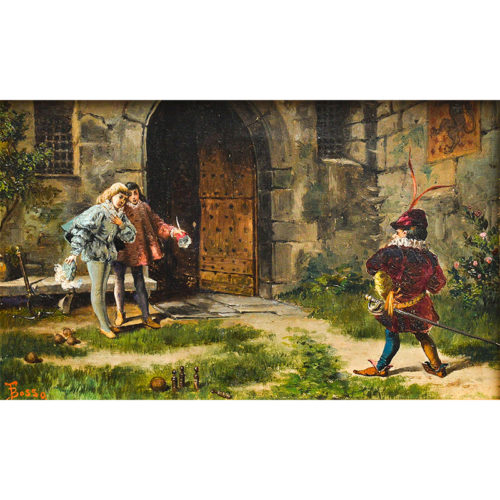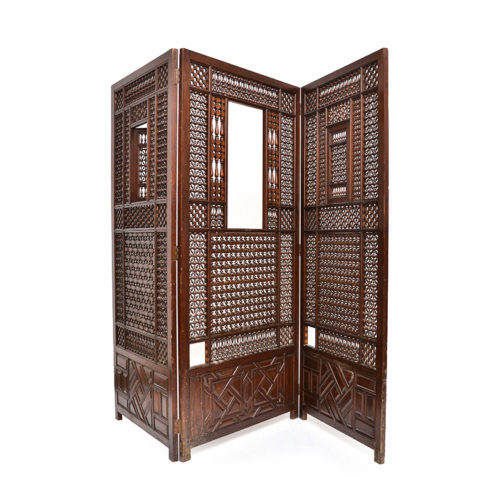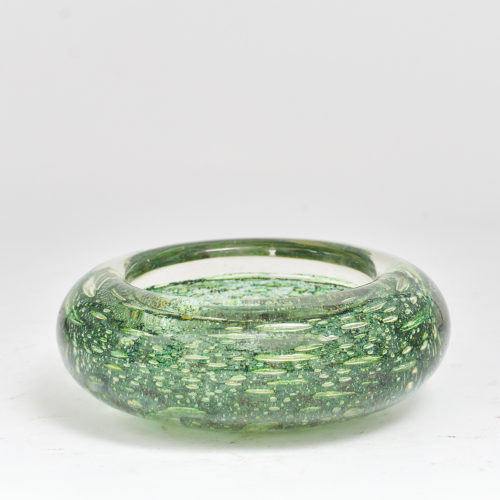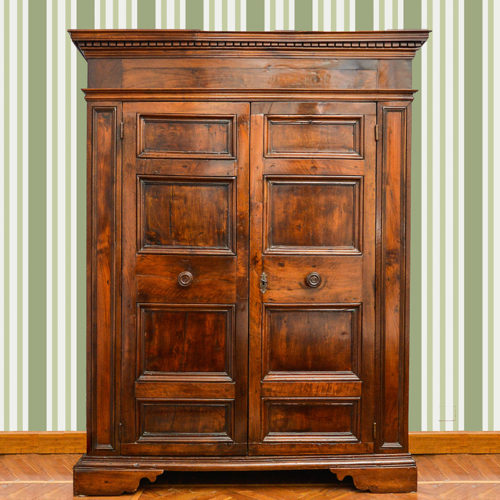"The challenge" - Oil on cardboard by Francesco Bosso (1864-1933)
BOSSO FRANCESCO. Born in Vercelli on December 27, 1864, died in Turin in 1933. He studied at the Institute of Fine Arts in his city with Bonino and Costa. At the beginning of his artistic career he devoted himself to decoration and scenography, performing several works in palaces, churches and theaters of Italy, France and Switzerland. For the Colonial Exhibition in Genoa he composed a large Diorama of the Panama Canal, appreciated and praised. He especially dedicated himself to the paintings of flowers, fruit and still lifes, which brought him wide fame. In 1922 forty-seven of his paintings were exhibited at the Vercelli Art Exhibition, including: Sun from the glass windows; Rustic rooms in Tournier; Among the rocks; Autumn melancholy; Fontanesian landscape and still lives.
-
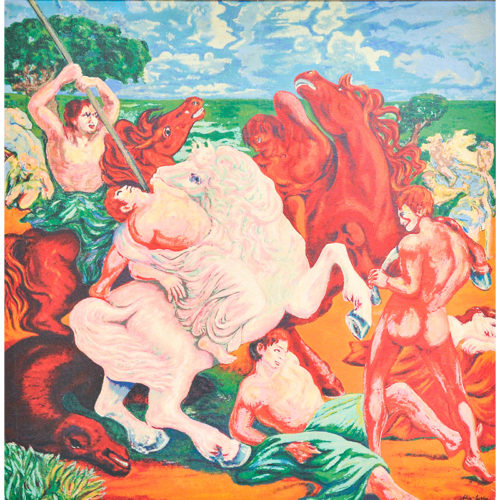 Large original screenprint by Aligi Sassu (1912-2000). SASSU ALIGI. Born on July 17, 1912 in Milan. For his father's Sardinian origins, he spent several years of his childhood in Thiesi (Sassari). His first essays are from 1926. He participated in the futurist movement until 1930; then he broke away. He had contacts in Milan with Edoardo Persico and Raffaele Carrieri; around 1931 he was in opposition to the Italian twentieth century, with Birolli, Manzù, Grosso, Tomea. He exhibited for the first time at the Venetian Biennale in 1928; his first personal is in 1930, at the Galleria del Milione. In 1934 he was in Paris, where he obtained success at the Galerie des Quatre Chemins. Since 1935, after returning to Milan, he has taken part in numerous artistic events. He participated in the first two editions of the Bergamo Prize; at the Sacred Art Exhibition in Bergamo he received the first prize with the work Deposition. He is an etching, lithographer, ceramist; he created works of sculpture, frescoes, stained glass, scenography. In 1957 he created a large cycle of mosaics in the apse of the Chiesa del Carmine in Cagliari; His works have been presented in numerous cities, including abroad: in the U.S.A. in 1933; in London in 1935; in Buenos Aires in 1947; and in Paris, Boston, Lisbon, Bucharest (where an anthology of paintings and graphic works was set up in 1966). Among the major solo shows in Italy, we mention: the one concerning graphics and sculpture carried out in the Galleria Civica di Monza in 1965; that of 1966 in Palermo presented by Salvatore Quasimodo; Period: 20th century Measures: H 163 x L 159 x P 4.5 / Canvas H 151 x L 146 cm
Large original screenprint by Aligi Sassu (1912-2000). SASSU ALIGI. Born on July 17, 1912 in Milan. For his father's Sardinian origins, he spent several years of his childhood in Thiesi (Sassari). His first essays are from 1926. He participated in the futurist movement until 1930; then he broke away. He had contacts in Milan with Edoardo Persico and Raffaele Carrieri; around 1931 he was in opposition to the Italian twentieth century, with Birolli, Manzù, Grosso, Tomea. He exhibited for the first time at the Venetian Biennale in 1928; his first personal is in 1930, at the Galleria del Milione. In 1934 he was in Paris, where he obtained success at the Galerie des Quatre Chemins. Since 1935, after returning to Milan, he has taken part in numerous artistic events. He participated in the first two editions of the Bergamo Prize; at the Sacred Art Exhibition in Bergamo he received the first prize with the work Deposition. He is an etching, lithographer, ceramist; he created works of sculpture, frescoes, stained glass, scenography. In 1957 he created a large cycle of mosaics in the apse of the Chiesa del Carmine in Cagliari; His works have been presented in numerous cities, including abroad: in the U.S.A. in 1933; in London in 1935; in Buenos Aires in 1947; and in Paris, Boston, Lisbon, Bucharest (where an anthology of paintings and graphic works was set up in 1966). Among the major solo shows in Italy, we mention: the one concerning graphics and sculpture carried out in the Galleria Civica di Monza in 1965; that of 1966 in Palermo presented by Salvatore Quasimodo; Period: 20th century Measures: H 163 x L 159 x P 4.5 / Canvas H 151 x L 146 cm -
Out of stock
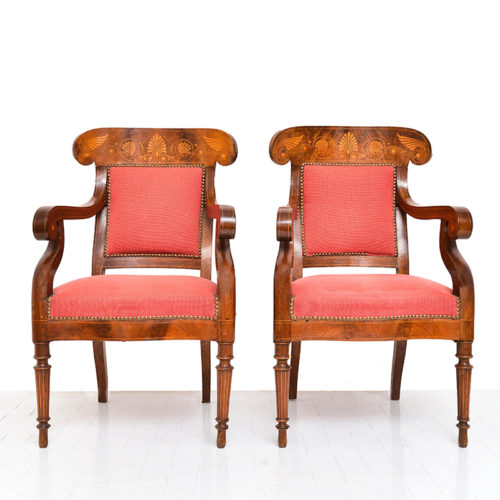 Period: around 1840 Measurements: H 100 x L 57 x P 56 x H seat 45 cmPair of Charles X armchairs, in walnut, inlaid in boxwood, dating back to the 1840s, red fabric in good condition, to be re-upholstered.
Period: around 1840 Measurements: H 100 x L 57 x P 56 x H seat 45 cmPair of Charles X armchairs, in walnut, inlaid in boxwood, dating back to the 1840s, red fabric in good condition, to be re-upholstered. -
Out of stock
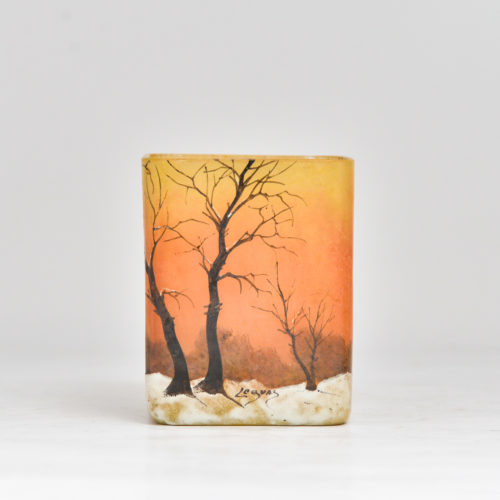 Period: Early 1900s Measurements: H 11.5 x L 9.5 x P 9.5 cmRefined small Legras vase with a square base in etched glass, decorated with a winter landscape, signed on the lower center, in excellent condition.
Period: Early 1900s Measurements: H 11.5 x L 9.5 x P 9.5 cmRefined small Legras vase with a square base in etched glass, decorated with a winter landscape, signed on the lower center, in excellent condition. -
Out of stock
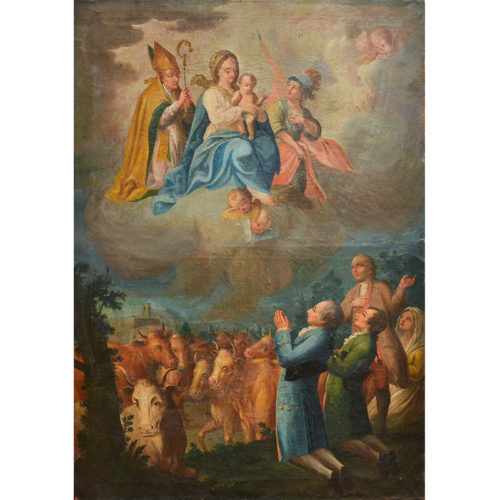 Period: 18th century Measurements: H 101 x L 71.5 x P 3 cm"Prayer" - Oil on canvas with religious scene, dating back to the 18th century
Period: 18th century Measurements: H 101 x L 71.5 x P 3 cm"Prayer" - Oil on canvas with religious scene, dating back to the 18th century -
Out of stock
 Period: Second half of the 18th century Measurements: H 83 x L 72 x P 4 / Canvas H 71.5 x L 51 cmPair of ovals canvasses depicting two portraits of aristocrats, man and woman, dating back to the second half of the eighteenth century, oil on canvas in a contemporary frame, restored and reintelated.
Period: Second half of the 18th century Measurements: H 83 x L 72 x P 4 / Canvas H 71.5 x L 51 cmPair of ovals canvasses depicting two portraits of aristocrats, man and woman, dating back to the second half of the eighteenth century, oil on canvas in a contemporary frame, restored and reintelated. -
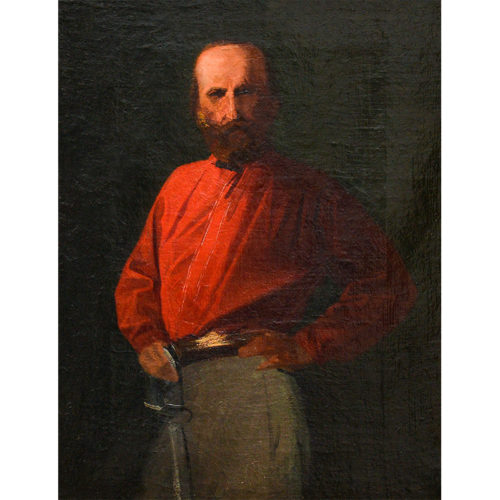 Period: 19th century Measurements: H 50 x L 41 x P 4.5 / Canvas H 39 x L 31 cm"Garibaldi" - Oil on canvas by Teofilo Patini (1840-1906) PATINI TEOFILO. Born in Castel di Sangro (L'Aquila) on May 5, 1840, died in Naples on November 16, 1906. He moved to Naples at a very young age, after graduating in Fine Arts; he enrolled at the Institute of Fine Arts, where Filippo Palizzi was teaching at the time. During the courses he easily won several prizes and finally obtained a pensioner to go to Rome, where he studied deeply the ancient masters and in particular those of the seventeenth century. He also was strongly influenced from Dutch paintings, but, above all, it was the Meissonnier who conquered him. He first dealt, for a short period of time, with the historical picture; then, with his sensitive and scornful soul, as an attentive observer of the events of human life, he gave himself to social painting, expressed with a strong and meticulous verism. His masterpiece is L'erede, which was exhibited in Milan in 1881 and is now found in the Gallery of Modern Art in Rome with Spade and Milk, exhibited in Turin in 1884. Other important paintings of his are: Il Parmigianino; The sack of Rome, of the Municipality of Naples; Art and freedom; Salvator Rosa's studio, exhibited in Turin in 1880 and in Vienna; Every good boot becomes a slipper; The first riding lesson, which is owned by the baritone Titta Ruffo; Pack animals, sent to Venice in 1887; Rocky landscape, in the M.O. collection of Milan; The riding lesson, in the Borgogna Museum of Vercelli; The country doctor; Belly and heart; The company of death: After defeat; The good ones; The notables of my country; The eagle; The caralluccio; Return to the sheepfold; The chain. Patini also tried, with less success, the sacred subject, and the paintings are remembered in this regard: Gloria del Sacramento; The temptations of Saint Anthony; Christ in the garden; The Redeemer; Christ raises the widow's son; The Annunziata; Il Purgatorio: The Crucifix; The Guardian Angel; Sant'Antonio di Padova; San Carlo Borromeo. There are also the sketches for the decorations of the Aula Magna of the University of Naples (work that, for the artist's death, remained unfinished), and the frescoes in the hall of the City Council of the same city. His students include M. Dragonetti Cappelli, E. Rubei, Vittor Scarselli.
Period: 19th century Measurements: H 50 x L 41 x P 4.5 / Canvas H 39 x L 31 cm"Garibaldi" - Oil on canvas by Teofilo Patini (1840-1906) PATINI TEOFILO. Born in Castel di Sangro (L'Aquila) on May 5, 1840, died in Naples on November 16, 1906. He moved to Naples at a very young age, after graduating in Fine Arts; he enrolled at the Institute of Fine Arts, where Filippo Palizzi was teaching at the time. During the courses he easily won several prizes and finally obtained a pensioner to go to Rome, where he studied deeply the ancient masters and in particular those of the seventeenth century. He also was strongly influenced from Dutch paintings, but, above all, it was the Meissonnier who conquered him. He first dealt, for a short period of time, with the historical picture; then, with his sensitive and scornful soul, as an attentive observer of the events of human life, he gave himself to social painting, expressed with a strong and meticulous verism. His masterpiece is L'erede, which was exhibited in Milan in 1881 and is now found in the Gallery of Modern Art in Rome with Spade and Milk, exhibited in Turin in 1884. Other important paintings of his are: Il Parmigianino; The sack of Rome, of the Municipality of Naples; Art and freedom; Salvator Rosa's studio, exhibited in Turin in 1880 and in Vienna; Every good boot becomes a slipper; The first riding lesson, which is owned by the baritone Titta Ruffo; Pack animals, sent to Venice in 1887; Rocky landscape, in the M.O. collection of Milan; The riding lesson, in the Borgogna Museum of Vercelli; The country doctor; Belly and heart; The company of death: After defeat; The good ones; The notables of my country; The eagle; The caralluccio; Return to the sheepfold; The chain. Patini also tried, with less success, the sacred subject, and the paintings are remembered in this regard: Gloria del Sacramento; The temptations of Saint Anthony; Christ in the garden; The Redeemer; Christ raises the widow's son; The Annunziata; Il Purgatorio: The Crucifix; The Guardian Angel; Sant'Antonio di Padova; San Carlo Borromeo. There are also the sketches for the decorations of the Aula Magna of the University of Naples (work that, for the artist's death, remained unfinished), and the frescoes in the hall of the City Council of the same city. His students include M. Dragonetti Cappelli, E. Rubei, Vittor Scarselli. -
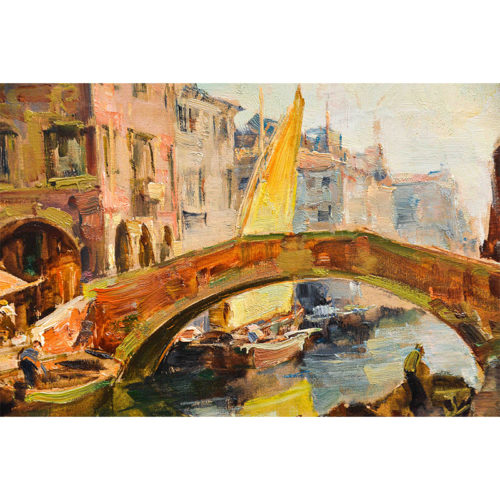 Period: 1940s / 50s Measurements: H 57 x L 67 x P 4 / Canvas H 41 x L 51.5 cm"Ponte dal Vigo, Canal Vena, Chioggia" - Oil on canvas by Angelo Brombo (1893-1962), dating back to the 1940s / 1950s. Signed on the lower right. BROMBO ANGELO. Born in Chioggia on January 5, 1893, he moved to Venice. He participated in the exhibitions in Venice Rome, Turin, Naples and other minor ones, from the Veneto region, with flattering success, and also in Rome in 1926 at the Mostra d'Arte Marinara, in Milan the following year, at the Primavera; in Bologna, Como, Rovigo; again in Rome; in Milan at the Mostra Peschereccia in 1939, where he obtained the gold medal of the Ministry of Agriculture. He has held solo shows in many Italian cities, receiving praise from the public and flattering judgments from critics for his personal, moving evidence in the marine theme. He has many works in private collections and among them: Polichromie chioggiotte (Conte Molini collection of Venice), Sails, Vita chioggiotta, La riva dei Rigattieri, Gray days, Shopping on board, Campo del Duomo (Pennasilico collection). Other works in public collections: The Mausoleum of Diocletian in Split (Capitoline Museum in Rome), Ruins of Nona (Collez. Comunale di Perugia), La Vela (Municipality of Cavarzere).
Period: 1940s / 50s Measurements: H 57 x L 67 x P 4 / Canvas H 41 x L 51.5 cm"Ponte dal Vigo, Canal Vena, Chioggia" - Oil on canvas by Angelo Brombo (1893-1962), dating back to the 1940s / 1950s. Signed on the lower right. BROMBO ANGELO. Born in Chioggia on January 5, 1893, he moved to Venice. He participated in the exhibitions in Venice Rome, Turin, Naples and other minor ones, from the Veneto region, with flattering success, and also in Rome in 1926 at the Mostra d'Arte Marinara, in Milan the following year, at the Primavera; in Bologna, Como, Rovigo; again in Rome; in Milan at the Mostra Peschereccia in 1939, where he obtained the gold medal of the Ministry of Agriculture. He has held solo shows in many Italian cities, receiving praise from the public and flattering judgments from critics for his personal, moving evidence in the marine theme. He has many works in private collections and among them: Polichromie chioggiotte (Conte Molini collection of Venice), Sails, Vita chioggiotta, La riva dei Rigattieri, Gray days, Shopping on board, Campo del Duomo (Pennasilico collection). Other works in public collections: The Mausoleum of Diocletian in Split (Capitoline Museum in Rome), Ruins of Nona (Collez. Comunale di Perugia), La Vela (Municipality of Cavarzere). -
Out of stock
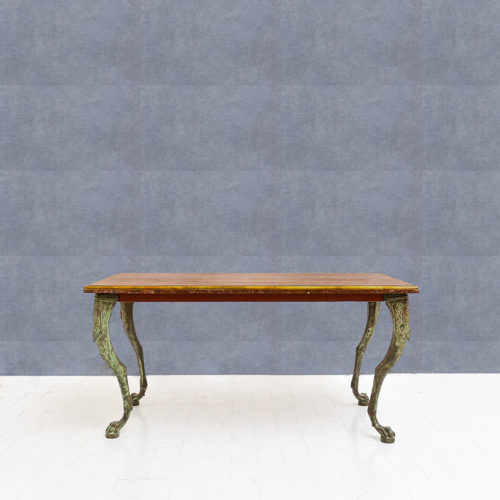 Period: 1920s Measurements: H 49.5 x L 100.5 x P 50 cmPeculiar coffee table, four-legged bronze base, greyhound paw shape, masks and decorations. Marble top.
Period: 1920s Measurements: H 49.5 x L 100.5 x P 50 cmPeculiar coffee table, four-legged bronze base, greyhound paw shape, masks and decorations. Marble top.
